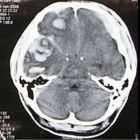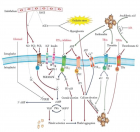Abstract
Research Article
Lemongrass tea consumption and changes in Acid-Base Balance and Electrolyte homeostasis
Christopher E Ekpenyong*
Published: 31 December, 2018 | Volume 2 - Issue 1 | Pages: 041-051
The consumption of dietary herbs and supplements may be associated with several physiological consequences including, but not limited to disturbances of acid-base homeostasis, minerals and electrolytes wasting, gastrointestinal disturbances as well as hemodynamic changes. Plants food based nutritional studies are important for assessing the effect of plants on human health and wellbeing. The aim of this study was to assess the changes in acid-base status and electrolyte homeostasis following the consumption of lemongrass tea. The acute and sub-chronic effects of infusions prepared from 2, 4, and 8g lemongrass leaf powder on serum and urinary pH, and electrolytes levels were assessed in 105 subjects using an interventional study design. The results post-treatment were compared with baseline values.
Plasma pH decreased from baseline value of 7.37 ± 0.02 to 7.20 ± 0.03, and 7.30 ± 0.02 at days 10 and 30 respectively for participants treated with infusion prepared from 2g of lemongrass leaf powder. For those treated with infusion prepared from 4g of lemongrass leaf powder, plasma pH decreased from baseline value of 7.35 ± 0.02 to 7.22 ± 0.02 and 7.29 ± 0.02 at days 10 and 30 respectively.
Treatment with infusion prepared from 8g of lemongrass leaf powder caused a decrease in plasma pH from baseline value of 7.38 ± 0.02 to 7.15 ± 0.02 and 7.18 ± 0.02 at days 10 and 30 respectively. Corresponding changes in urinary pH were also observed. Furthermore, at days 10 and 30, plasma protein concentrations increased significantly (p < 0.05) in subjects treated with infusion prepared from 8g lemongrass leaf extract. There were also significant increases (p < 0.05) in urinary volume, urination frequency, and urinary electrolytes levels within the same period.
The consumption of lemongrass tea may be associated with changes in acid-base balance and electrolyte homeostasis due to its varied biological constituents and their activities
Read Full Article HTML DOI: 10.29328/journal.afns.1001016 Cite this Article Read Full Article PDF
Keywords:
Cymbopogon citratus; pH changes; Electrolyte disturbance.
References
- Blowey DL. Nephrotoxicity of over-the-counter analgesics, natural medicines, and illicit drugs. Adolesc Med. 2005; 16: 31-43. Ref.: https://goo.gl/9SPB7p
- Ifudu O, Friedman EA. Kidney injury, electrolyte and acid-base abnormalities associated with use of alternative medicine product. Dial Transplant. 2009; 38: 124-127. Ref.: https://goo.gl/yYmDWP
- Luyckx VA, Steenkamp V, Stewart MJ. Acute Renal Failure Associated With the Use of Traditional Folk Remedies In South Africa. Ren Fail. 2005; 27: 35-43. Ref.: https://goo.gl/cNyz6s
- Muller BA, Scott MK, Sowinski KM, Prag KA. Noni juice (morinda citrifolia): hidden potential for hyperkalemia. Am J Kidney Dis. 2000; 35: 310-312. Ref.: https://goo.gl/bQdwfD
- Nagasaki A, Takamine W, Taksu N. Severe hyperalemia associated with “alternative” nutritional cancer therapy. Clinical Nutrition. 2005; 24: 864-865. Ref.: https://goo.gl/xDE5Py
- Tsai CS, Chen YC, Chen HH, Cheng CJ, Lin SH. An Unusual Cause of Hypokalemia Paralysis: Aristolochic Acid Nephropathy with Fanconi Syndrome. Am J Medical Sciences. 2005; 330: 153-155. Ref.: https://goo.gl/ZsyWYE
- Cheng CJ, Chen YH, Chau T, Lin SH. A hidden cause of hypokalemic paralysis in a patient with prostate cancer. Support care cancer. 2004; 12: 810-812. Ref.: https://goo.gl/2C4pMd
- Ko RJ. Adulterants in Asian patent medicines. New Engl J Med. 1998; 339: 847. Ref.: https://goo.gl/D7t7xQ
- Haller CA, Dyer JE, Ko R, Olson KR. Making a diagnosis of herbal related toxic hepatitis. Western Journal of Medicine. 2002; 176: 39-44. Ref.: https://goo.gl/1UWyNJ
- Lee JJ, Chen HC. Flavonoids-induced acute nephropathy by Cupressus funebris Endl (Mourning cypress). Am J Kidney Dis. 2006; 48: e81-85. Ref.: https://goo.gl/6kjTHu
- Westendorf ML, Gordon R. Effect of increasing undegradable intake protein when sheep are fed diets low in protein. Prof Anim Sci. 1998; 14: 16-21. Ref.: https://goo.gl/kMMyK2
- Tarkang PA, Agbor GA, Tsabang N, Tchokouaha RY, et al. Effect of Long-Term Oral Administration of The Aqueous and Ethanol Leaf Extract Of Cymbopogon Citratus (DC. Ex Ness) Stapf. Annals of Biological Research. 2012; 3: 5561-5570.
- Carlini EA, Contar J de DP, Silva-Filho AR, da Silveira-Filho NG, Frochtengarten ML, et al., Pharmacology of Lemon Grass (Cymbopogon citratus Stapf.): Effects of Teas Prepared from the Leaves on Laboratory Animals. J Ethnopharmacol. 1986; 17: 37-64. Ref.: https://goo.gl/P5Lo1F
- Nambiar VS, Matela H. Potential function of lemongrass (Cymbopogon citratus) in health and disease. Int J Pharm Biol Arc. 2012; 3: 1035-1043. Ref.: https://goo.gl/KES43R
- Ekpenyong CE, Daniel NE, Atai AB. Effect of Lemongrass tea consumption on estimated glomerular filtration rate and creatinine clearance rate. J Renal Nutrition. 2015; 25: 57-66. Ref.: https://goo.gl/n6Yt3E
- Ferreira MS, Fonteles MC. Aspectos etnobotanicos efarma cologicos do Cymbopogon citratus staph (capim limao). Revita Brasileira de Farmacia. 1989; 70: 94-97.
- Tzortzakis NG, Economakis CD. Antifungal activity of lemongrass (Cymbopogon citratus) essential oil against key pst-harvest pathogens. Innov Food Sci Emerg (IFSET). 2007; 8: 253-258. Ref.: https://goo.gl/jbspN1
- Paranagama PA, Abeysekera KHT, Abeywickrama K, Nugaliyadde L. Fungicidal and anti-aflatoxigenic effects of the essential oil of Cymbopogon citratus (DC.) Stapf. (lemongrass) against Aspergillus flavus Link. isolated from stored rice. Lett Appl Microbiol. 2003; 37: 86-90. Ref.: https://goo.gl/Aj1fUf
- Leite JR, Seebra MV, Maluf E, Assolant K, Suchecki D, et al. Pharmacology of lemongrass (Cymbopogon citratus) 111. Assessment of eventual toxic; hypnotic and anxiolytic effects on humans. J Ethnopharmacol. 1986; 17: 75-83. Ref.: https://goo.gl/8q3vBm
- Lahlou S, Figueiredo AF, Magalhoes PJ, Leal-Cardoso JH. Cardiovascular effects of 1, 8-cineole, a terpenoid oxide present in many plants essential oil in normotensive rats. Can J Physiol Pharmacol. 2007; 80: 1125-1131. Ref.: https://goo.gl/baWfXz
- Wright CI, Van-Buren L, Kroner CI, Koning MM. Herbal Medicines as Diuretics: A review of scientific evidence. J Ethnopharmacol. 2007; 114: 1-31. Ref.: https://goo.gl/758NT4
- Pauler PE, Zubeita-Calleja OR. Essential in the Diagnosis of Acid-Base Disorders and Their High Altitude Application. Journal of Physiology and Pharmacology. 2005; 56, Suppl 4: 155-170. Ref.: https://goo.gl/B4UZGA
- Schwalfenberg GK. The Alkaline Diet: Is There Evidence That an Alkaline Ph Diet Benefits Health? J Environ Public Health. 2012; 2012:727630. Ref.: https://goo.gl/jzAcP6
- Oloyede IO. Chemical profile and antimicrobial activity of Cymbopogon citratus leaves. Journal of Natural Product. 2009; 2: 98-103. Ref.: https://goo.gl/Ni2F65
- Vendruscolo GS, Maris S, Rates K, Mentz LA. Chemical and pharmacologic data on medical plants used by the community of the Ponta Grossa neighborhood, Porto Alegre, Rio Grande do Sul, Brazil. Brazilian Journal of Pharmacognosy. 2005; 15: 361-372. Ref.: https://goo.gl/jwyk4S
- Aftab K, Ali MD, Aijaz P, Beena N, Gulzar HJ, et al. Determination of different trace and essential element in lemongrass samples by x-ray fluorescence spectroscopy technique. Int Food Res J. 2011; 18: 265-270. Ref.: https://goo.gl/uP5SY7
- de Souza, De Souza AM, Lara L, Previato JO, Lopesa AG, et al. Modulation of sodium pumps by steroidal saponins. Z Naturforsch C. 2004; 59: 432-436. Ref.: https://goo.gl/3PLDFu
- Rhiouani H, Settaf A, Lyoussi B, Cherrah Y, Lacaille-Dubois MA et al. Effects of sap on ins. from Hemiaria glabra on blood pressure and renal function in spontaneously hypertensive rats. Therapie.1999; 54: 735-739. Ref.: https://goo.gl/kPmwrQ
- Jouad H, Haloui M, Rhiouani H, El Hilaly J, Eddouks M. Ethnobotanical survey of medicinal plants used for the treatment of diabetes, cardiac and renal diseases in the North centre region of Morocco (Fez–Boulemane). J Ethnopharmacol. 2001; 77: 175–182. Ref.: https://goo.gl/fEcFjk
- Hiwatashi K, Shirakawa H, Hori K, Yoshiki Y, Suzuki N, et al. Reduction of blood pressure by Soya bean saponins, Rennin inhibitors from Soya bean, in spontaneously hypertensive Rats. Bioscience Biotechnology Biochemistry. 2010; 74: 2310-2312.
- Chen M, Long Z, Wang Y, Iu J, Pian H, et al. Protective effect of Saponin on a hypertension target organ in spontaneously hypertensive rats. Exp Ther Med. 2013; 5: 429-432. Ref.: https://goo.gl/Dw9AT8
- Giovannucci E, Liu Y, Hollis BW, Rimm EB. 25-Hydroxyvitamin D and Risk of Myocardial infection in men: a prospective study. Arch of Int. Medicine. 2008; 168: 1774-1180. Ref.: https://goo.gl/Jg2mqP
- Aoi W, Niisalo N, Miyazaki H and Marunaka Y. Flavonoid-Induced Reduction of ENAC Expression in the Kidney of Dahl Salt-Sensitive Hypertensive Rat. Biochem Biophys Res Commun.2004; 315: 892-896. Ref.: https://goo.gl/3x47Cd
- Akande IS, Samuel TA, Agbazue U, Olowolagba BL. Comparative Proximate Analysis of Ethanolic and Water Extracts of Cymbopogon citratus (Lemon grass) and Four Tea Brands. Plant Sciences Research.2011; 3: 29-35. Ref.: https://goo.gl/jvwwLv
- Arhoghro EM, Kpomah ED. Cymbopogon citratus aqueous extract alleviates cisplatin-induced renal oxidative stress and toxicity in albino rats. American Journal of Research Communication. 2013; 3: 100-125. Ref.: https://goo.gl/D631SA
- Mardon J, Habauzit V, Trzeciakiewiucz A, Davicco MJ, Lebecque P, et al. Long-term intake of a high protein diet with or without potassium citrate modulates acid-base metabolism, but not bone status, in male rats. J Nutr. 2008; 138: 718-724. Ref.: https://goo.gl/TW3b2L
- Erdmann K, Cheung B, Schröder H. The possible roles of food derived bioactive peptides in reducing the risk of cardiovascular disease. J Nutr Biochem. 2008; 19: 643-654. Ref.: https://goo.gl/NrKxXf
- Farooqi ZR, Iqbal MZ, Shafiq M. Toxic effects of lead and cadmium on germination and growth of Albizia lebbeck (L.) Benth. Pak J Bot. 2009; 41: 27-33. Ref.: https://goo.gl/hu4in3
- Pizzorno J, Frassetto LA, Katzinger J. Diet-Induced Acidosis: Is It Real and Clinically Relevant? Br J Nutr. 2010; 103: 1185-1194. Ref.: https://goo.gl/PHAK2M
- Adam WR, Dawborn JK. Potassium Tolerance in Rats. Aust J Exp Biol Med Sci. 1972; 50: 757-768. Ref.: https://goo.gl/hqP8Rr
- Young DB, Mccaa RE, Pan Y, Guyton AC. The Natriuretic and Hypotensive Effects of Potassium. Circ Res. 1976; 38 (Suppl II): 84-89. Ref.: https://goo.gl/VfsZi1
- Dluhy RG, Underwood RH, Williams GH. Influence of Dietary Potassium on Plasma Rennin Activity in Normal Man. J Appl Physiol. 1970; 28: 299-302. Ref.: https://goo.gl/R8g1f4
- Flamenbaum WTA, Kotchen RN, Mcneil JD. Effect of Potassium on the Rennin-Angiotensin System and Hgcl2 Induced Acute Renal Failure. American Journal of Physiology. 1973; 224: 305-311. Ref.: https://goo.gl/yrTNYC
- Brunner HR, Baer L, Sealey JE. The Influence of Potassium Administration and Deprivation on Renin in Normal and Hypertensive Subjects. J Clin Invest. 1970; 49: 2128-2138. Ref.: https://goo.gl/uCfZMG
- Wenzel U. Aldosterone Antagonist: Silver Bullet or just Sodium Excretion and Potassium Retention? Kidney Int. 2007; 71: 374-376. Ref.: https://goo.gl/EqQc2H
- Von Bunge G. Concerning the Significant Of Table Salt in the Human Organism. Zeitschrift Fur Biologie. 1873; 9: 104-143.
- Michelson O, Makdani D, Gill JL, Frank RL. Sodium and Potassium Intakes and Excretions of Normal Men Consuming Sodium Chloride or a 1:1 Mixture of Sodium and Potassium Chlorides. American Journal of Clinical Nutrition. 1977; 30: 2033. Ref.: https://goo.gl/ugR5Lu
- Treasure J, Ploth D. Role of Dietary Potassium in the Treatment of Hypertension. Hypertension. 1983; 5:864-872. Ref.: https://goo.gl/MuLxUt
- Jeon US. Kidney and calcium homeostasis. Electrolyte and bllod pressure. 2008; 6: 68-76. Ref.: https://goo.gl/dDTk5v
- Carbajal D, Casaco L, Arruzazabala L, Gonzalaz R, Tolon Z. Pharmacological study of Cymbopogon citratus leaves. J Ethnopharmacol. 1989; 25: 103-107. Ref.: https://goo.gl/3yXsQ7
- Caluscusin IR. The effect of twice-a-day intake of lemon grass decoction among hypertensive individuals in Barangay Situbo, municipality of Tampilis province of Zamboangadel Norte. ADZU-SOM 2010; Ref.: https://goo.gl/BUvzdw
- Ekpenyong C, Daniel N, Akpan E. Phytoconstituents and diuretic activity of Cymbopogon citratus leaf infusions in humans. J Coastao Life Med. 2014; 2:704-713. Ref.: https://goo.gl/Xn4u7P
- Moe OW, Huang CL. Hypercalciuria from Acid Load: Renal Mechanisms. J Nephrol. 2006; 19: 53-61. Ref.: https://goo.gl/nhKydQ
- Yeh BI, Kim YK, Jabbar W, Huang CL. Conformational Changes of Pore Helix Coupled to Gating Of TRPVS By Protons. European Molecular Biology Organization Journal. 2005; 24: 3224-3234. Ref.: https://goo.gl/HKY1Qw
Similar Articles
Recently Viewed
-
Leiomyosarcoma in pregnancy: Incidental finding during routine caesarean sectionToon Wen Tang*,Phoon Wai Leng Jessie. Leiomyosarcoma in pregnancy: Incidental finding during routine caesarean section. Clin J Obstet Gynecol. 2021: doi: 10.29328/journal.cjog.1001094; 4: 092-095
-
Adult Neurogenesis: A Review of Current Perspectives and Implications for Neuroscience ResearchAlex, Gideon S*,Olanrewaju Oluwaseun Oke,Joy Wilberforce Ekokojde,Tolulope Judah Gbayisomore,Martina C. Anene-Ogbe,Farounbi Glory,Joshua Ayodele Yusuf. Adult Neurogenesis: A Review of Current Perspectives and Implications for Neuroscience Research. J Neurosci Neurol Disord. 2024: doi: 10.29328/journal.jnnd.1001102; 8: 106-114
-
Late discover of a traumatic cardiac injury: Case reportBenlafqih C,Bouhdadi H*,Bakkali A,Rhissassi J,Sayah R,Laaroussi M. Late discover of a traumatic cardiac injury: Case report. J Cardiol Cardiovasc Med. 2019: doi: 10.29328/journal.jccm.1001048; 4: 100-102
-
A two-phase sonographic study among women with infertility who first had normal sonographic findingsKalu Ochie*,Abraham John C. A two-phase sonographic study among women with infertility who first had normal sonographic findings. Clin J Obstet Gynecol. 2022: doi: 10.29328/journal.cjog.1001117; 5: 101-103
-
Sinonasal Myxoma Extending into the Orbit in a 4-Year Old: A Case PresentationJulian A Purrinos*, Ramzi Younis. Sinonasal Myxoma Extending into the Orbit in a 4-Year Old: A Case Presentation. Arch Case Rep. 2024: doi: 10.29328/journal.acr.1001099; 8: 075-077
Most Viewed
-
Evaluation of Biostimulants Based on Recovered Protein Hydrolysates from Animal By-products as Plant Growth EnhancersH Pérez-Aguilar*, M Lacruz-Asaro, F Arán-Ais. Evaluation of Biostimulants Based on Recovered Protein Hydrolysates from Animal By-products as Plant Growth Enhancers. J Plant Sci Phytopathol. 2023 doi: 10.29328/journal.jpsp.1001104; 7: 042-047
-
Sinonasal Myxoma Extending into the Orbit in a 4-Year Old: A Case PresentationJulian A Purrinos*, Ramzi Younis. Sinonasal Myxoma Extending into the Orbit in a 4-Year Old: A Case Presentation. Arch Case Rep. 2024 doi: 10.29328/journal.acr.1001099; 8: 075-077
-
Feasibility study of magnetic sensing for detecting single-neuron action potentialsDenis Tonini,Kai Wu,Renata Saha,Jian-Ping Wang*. Feasibility study of magnetic sensing for detecting single-neuron action potentials. Ann Biomed Sci Eng. 2022 doi: 10.29328/journal.abse.1001018; 6: 019-029
-
Pediatric Dysgerminoma: Unveiling a Rare Ovarian TumorFaten Limaiem*, Khalil Saffar, Ahmed Halouani. Pediatric Dysgerminoma: Unveiling a Rare Ovarian Tumor. Arch Case Rep. 2024 doi: 10.29328/journal.acr.1001087; 8: 010-013
-
Physical activity can change the physiological and psychological circumstances during COVID-19 pandemic: A narrative reviewKhashayar Maroufi*. Physical activity can change the physiological and psychological circumstances during COVID-19 pandemic: A narrative review. J Sports Med Ther. 2021 doi: 10.29328/journal.jsmt.1001051; 6: 001-007

HSPI: We're glad you're here. Please click "create a new Query" if you are a new visitor to our website and need further information from us.
If you are already a member of our network and need to keep track of any developments regarding a question you have already submitted, click "take me to my Query."


















































































































































